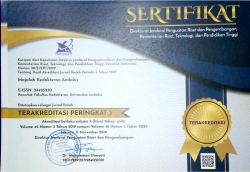Deteksi crypstosporidium sp. pada pasien dengan kanker kolorektal
Abstract
Cryptosporidium sp. adalah parasit obligat intraseluler yang menyerang sel epitel usus. Infeksinya mengakibatkan diare, malnutrisi, dehidrasi dan cedera usus terutama pada orang dengan gangguan imunitas. Tingginya infeksi Cryptosporidium pada pasien HIV-AIDS pada penelitian sebelumnya menandakan sumber infeksi yang tinggi di lingkungan. Cryptosporidium dilaporkan memiliki hubungan dengan kanker kolorektal baru-baru ini. Tujuan: tujuan penelitian ini adalah untuk mengetahui prevalensi infeksi Cryptosporidium pada pasien dengan kanker kolorektal. Metode: metode yang digunakan observasional dengan desain cross-sectional study pada 43 pasien kanker kolorektal yang sesuai dengan kriteria yaitu pasien yang baru didiagnosis dan belum mendapatkan terapi onkologis. Pengumpulan sampel feses dilakukan dari bulan April hingga Agustus 2023. Pemeriksaan ookista dilakukan secara mikroskopik dengan pewarnaan tahan asam modifikasi ziehl neelsen. Hasil: hasil penelitian didapatkan 46,5% (20/43) pasien positif terinfeksi Cryptosporidium. Kesimpulan: kesimpulan hasil penelitian, infeksi Cryptosporidium tinggi pada pasien kanker kolorektal, terutama pada lokasi kanker rektum. Penelitian lebih lanjut untuk mengetahui spesies Cryptosporidium diperlukan untuk mengetahui rute penularan dan sumber infeksi.
Keywords
Full Text:
PDFReferences
The Global Cancer Observatory. Epidemiology of rectum cancer in the World 2020. Int Agency Res Cancer. 2020;419:7–8.
Sung JJY, Chiu H-M, Lieberman D, Kuipers EJ, Rutter MD, Macrae F, et al. Third Asia-Pacific consensus recommendations on colorectal cancer screening and postpolypectomy surveillance. Gut [Internet]. 2022 Nov;71(11):2152–66.
Morgan E, Arnold M, Gini A, Lorenzoni V, Cabasag CJ, Laversanne M, et al. Global burden of colorectal cancer in 2020 and 2040: incidence and mortality estimates from GLOBOCAN. Gut [Internet]. 2022 Sep 8;gutjnl-2022-327736.
Hasan MF. Karakteristik Klinikopatologi Kanker Kolorektal Di Laboratorium Patologi Anatomi RSUP Dr. M. Djamil Padang Tahun 2017-2020. Universitas Andalas; 2022.
Ziegler, John L, Buonaguro FM. Infectious agents and human malignancies. Front Biosci [Internet]. 2009;Volume(14):3455. Available from:
IARC. Biological Agents [Internet]. Vol. 100, International Agency for Research on Cancer. International Agency for Research on Cancer; 2012. 1–499 p.
Sulzyc-Bielicka V, Kuźna-Grygiel W, Kołodziejczyk L, Bielicki D, Kładny J, Stȩpień-Korzonek M, et al. Cryptosporidiosis in patients with colorectal cancer. J Parasitol. 2007;93(3):722–4.
Certad G, Ngouanesavanh T, Guyot K, Gantois N, Chassat T, Mouray A, et al. Cryptosporidium parvum, a potential cause of colic adenocarcinoma. Infect Agent Cancer [Internet]. 2007 Dec 21;2(1):22.
Certad G, Creusy C, Ngouanesavanh T, Guyot K, Gantois N, Mouray A, et al. Development of Cryptosporidium parvum-induced gastrointestinal neoplasia in severe combined immunodeficiency (SCID) mice: Severity of lesions is correlated with infection intensity. Am J Trop Med Hyg. 2010;82(2):257–65.
Creusy C, Certad G, Guyot K, Dei-Cas E. Parasites and oncogenesis with a special reference to gastro-intestinal neoplasia induced by cryptosporidium parvum. NATO Sci Peace Secur Ser A Chem Biol. 2010;381–8.
Benamrouz S, Guyot K, Gazzola S, Mouray A, Chassat T, Delaire B, et al. Cryptosporidium parvum Infection in SCID Mice Infected with Only One Oocyst: qPCR Assessment of Parasite Replication in Tissues and Development of Digestive Cancer. Langsley G, editor. PLoS One [Internet]. 2012 Dec 13;7(12):e51232.
Abdou AG, Harba NM, Afifi AF, Elnaidany NF. Assessment of Cryptosporidium parvum infection in immunocompetent and immunocompromised mice and its role in triggering intestinal dysplasia. Int J Infect Dis [Internet]. 2013;17(8):e593–600.
Certad G, Creusy C, Guyot K, Mouray A, Chassat T, Delaire B, et al. Fulminant cryptosporidiosis associated with digestive adenocarcinoma in SCID mice infected with Cryptosporidium parvum TUM1 strain. Int J Parasitol [Internet]. 2010;40(13):1469–75.
Tzipori S, Widmer G. A hundred-year retrospective on cryptosporidiosis. Trends Parasitol. 2008;24(4):184–9.
Meisel JL, Perera DR, Meligro C, Rubin CE. Overwhelming Watery Diarrhea Associated with a Cryptosporidium in an Immunosuppressed Patient. Gastroenterology [Internet]. 1976;70(6):1156–60.
Nime FA, Burek JD, Page DL, Holscher MA, Yardley JH. Acute Enterocolitis in a Human Being Infected with the Protozoan Cryptosporidium. Gastroenterology [Internet]. 1976;70(4):592–8.
Khalil IA, Troeger C, Rao PC, Blacker BF, Brown A, Brewer TG, et al. Morbidity, mortality, and long-term consequences associated with diarrhoea from Cryptosporidium infection in children younger than 5 years: a meta-analyses study. Lancet Glob Heal [Internet]. 2018;6(7):e758–68.
Ryan UM, Feng Y, Fayer R, Xiao L. Taxonomy and molecular epidemiology of Cryptosporidium and Giardia – a 50 year perspective (1971–2021). Int J Parasitol [Internet]. 2021 Dec [cited 2022 Jan 3];51(13–14):1099–119.
Thomson S, Hamilton CA, Hope JC, Katzer F, Mabbott NA, Morrison LJ, et al. Bovine cryptosporidiosis: impact, host-parasite interaction and control strategies. Vet Res. 2017;48(1):42.
Bouzid M, Hunter PR, Chalmers RM, Tyler KM. Cryptosporidium pathogenicity and virulence. Clin Microbiol Rev. 2013;26(1):115–34.
Fayer R, Morgan U, Upton SJ. Epidemiology of Cryptosporidium: Transmission, detection and identification. Int J Parasitol. 2000;30(12–13):1305–22.
Bouzid M, Kintz E, Hunter PR. Risk factors for Cryptosporidium infection in low and middle income countries: A systematic review and meta-analysis. PLoS Negl Trop Dis. 2018;12(6):1–13.
Adler S, Widerström M, Lindh J, Lilja M. Symptoms and risk factors of Cryptosporidium hominis infection in children: data from a large waterborne outbreak in Sweden. Parasitol Res. 2017;116(10):2613–8.
Kumar A, Chatterjee I, Anbazhagan AN, Jayawardena D, Alrefai WA, Sun J, et al. HHS Public Access. 2019;20(6):1–29.
Petry F, Jakobi V, Tessema TS. Host immune response to Cryptosporidium parvum infection. Exp Parasitol [Internet]. 2010;126(3):304–9. Available from:
Fayer R, Xiao L. Cryptosporidium and Cryptosporidiosis. Second. Fayer R, Xiao L, editors. Dairy Science & Technology, CRC Taylor & Francis Group. CRC Press-Taylor and Francis Group LLC; 2008. 1–542 p.
Lumadue JA, Manabe YC, Moore RD, Belitsos PC, Sears CL, Clark DP. A clinicopathologic analysis of AIDS-related cryptosporidiosis. Aids. 1998;12(18):2459–66.
Handayani SW. Hubungan Jumlah Sel CD4 dengan Infeksi Cryptosporidium spp. (Diare/Non Diare) Pada Pasien HIV/AIDS Di RS. Dr. M. Djamil Padang. Padang: Universitas Andalas; 2017.
Sulżyc-Bielicka V, Kołodziejczyk L, Jaczewska S, Bielicki D, Safranow K, Bielicki P, et al. Colorectal cancer and Cryptosporidium spp. infection. PLoS One. 2018;13(4).
Osman M, Benamrouz S, Guyot K, Baydoun M, Frealle E, Chabe M, et al. High association of Cryptosporidium spp. infection with colon adenocarcinoma in Lebanese patients. Chamaillard M, editor. PLoS One [Internet]. 2017 Dec 19;12(12):e0189422.
Orenstein JM, Dieterich DT. The histopathology of 103 consecutive colonoscopy biopsies from 82 symptomatic patients with acquired immunodeficiency syndrome: Original and look-back diagnoses. Arch Pathol Lab Med. 2001;125(8):1042–6.





















